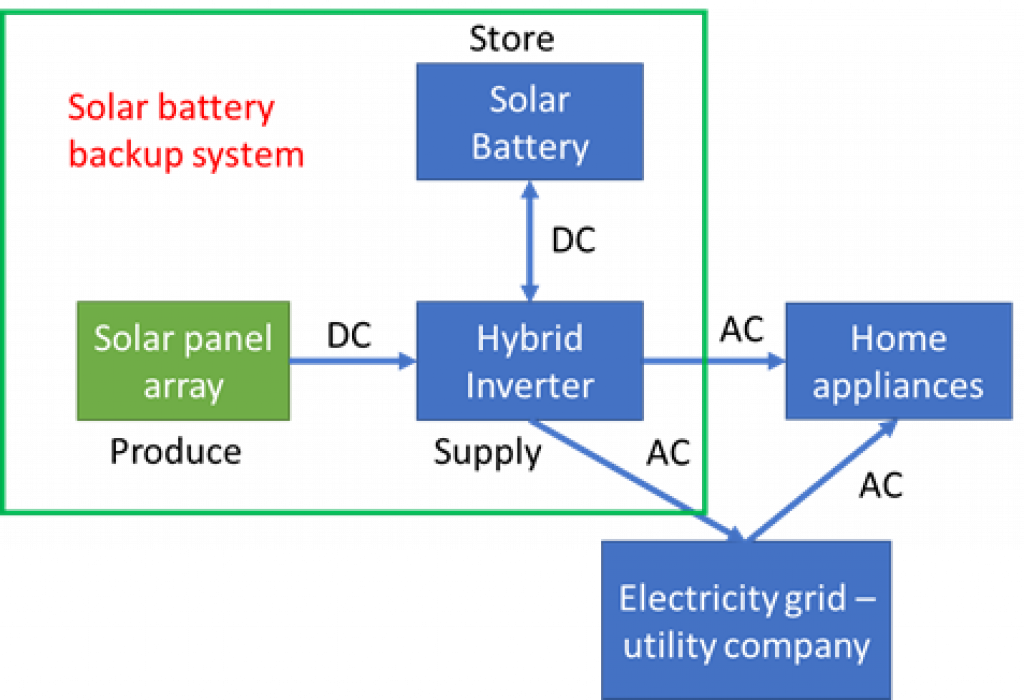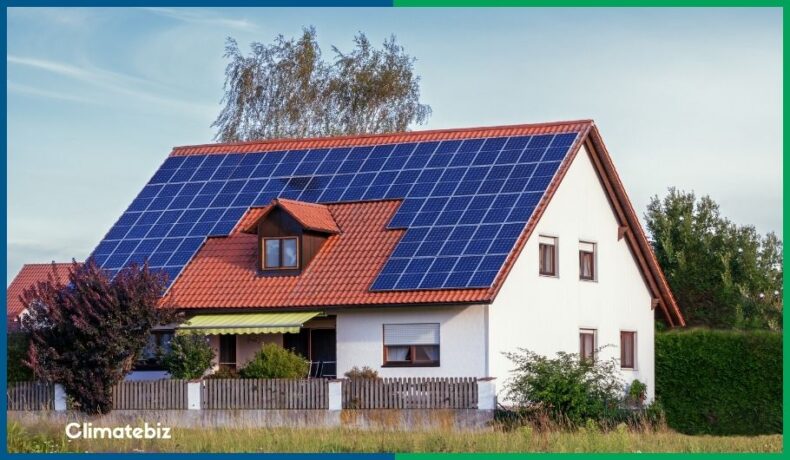Are persistent power outages getting you down? Then it’s time that you invest in a solar battery backup system.
Each year, millions of electricity customers across the U.S. experience power failures. In 2020, the average duration per household was 8 hours.
But, this is only the tip of the iceberg. States such as Louisiana, Texas, and California are prone to major electrical failures (up to 60 hours) due to extreme climatic events and weak power grid resilience.
These outages have devastating effects on both domestic life and local economies.
Fortunately, there is a solution to cope with these recurrent power failures — solar battery backup systems.
In our homeowner’s guide, you will learn how these systems operate, what they cost, and the type of system you’ll require to get you through any power outage that comes your way.
Table of Contents
What Is A Solar Battery Backup System?
A Solar battery backup system is also called a solar UPS (Uninterrupted Power Supply). In other words, it is designed to supply electricity seamlessly to your domestic appliances during a power failure.
Furthermore, this backup system generates electricity from the sun at all times — you can then use this extra power in your house or sell it to your local utility company.
A basic solar battery backup system comprises three main components installed:
- Solar panels
- Hybrid inverter
- Solar battery
How Does A Solar Battery Backup Work?
A solar battery backup system’s main components perform 3 major functions:
- Solar panel array: production
- Solar inverter: supply
- Solar battery: storage
Let’s look at each component and see how they interact.
Solar Panel Array: Production
Solar panels use sunlight to generate electricity in the form of DC (direct current). Organizing these solar modules in an array of several or more units helps them reach a higher power output.
Solar Inverter: Supply
The inverter is the “brain” of your solar backup system.
In this case, you’ll need a hybrid or off-grid inverter. This inverter regulates your battery’s charge (DC) with solar energy and supplies power to your house or utility company. Furthermore, it automatically detects a power outage and switches to the housing supply in the blink of an eye.
Solar inverters are programmable; you can monitor and control them via a mobile phone app.
Solar Battery: Storage
A solar battery is essential to your solar battery backup system. It ensures a smooth and continuous power supply in case of a power outage.
Solar Battery Backup System Diagram
Let’s take a look at how the three primary components of a solar battery backup interact with each other.
As seen below, DC electricity is produced by the solar panels and stored in the battery via an inverter.

Thereafter, the hybrid inverter has two options:
- Convert DC from the battery into AC (Alternating Current) to supply power to your house (this occurs during a power failure).
- Send electricity to your local utility company, which will pay you in return.
Inverters are flexible devices; you can also instruct them to directly supply solar energy directly to your house even if there isn’t a power outage.
Who Should Get Solar Battery Backup?
Any homeowner looking to use their appliances in a stress-free manner during a power failure should invest in a solar battery backup system.
Not only will these backup systems protect your appliances in the event of grid failure, but they can also help you reduce your monthly electricity bill by allowing you to produce your own electricity.
As a bonus, solar battery backups are virtually maintenance-free and operate seamlessly — just one more reason for you to get a backup system!
What Size Solar Battery Backup Do You Need?
You have two options when designing your solar battery backup system:
- A complete backup of your home electrical system
- A partial backup of your essential appliances
Obviously, the more appliances you need to power, the larger your system will be.
In both cases, the goal is to power your appliances for at least 24 hours straight; this will get you through 99% of all power outages.
The following are examples of a complete and partial backup system:
Size Of A Total Backup System
To correctly size your solar battery backup system, you’ll need to know your daily electricity consumption — look at your electricity bill, your energy consumption is indicated in kWh.
Let’s consider the average U.S. household’s daily electricity consumption of 30 kWh.
As previously mentioned, a solar battery backup system consists of three primary parts (solar panel, hybrid inverter, and solar battery). Each must be sized according to demand.
Solar Battery Size
The most important part of the system is the solar battery. To have a sufficient backup, especially in areas prone to long power interruptions, we recommend a storage capacity equivalent to a full day of electricity use. In this case: 30 kWh of battery storage.
Solar Panel Size
Size your solar panel array to produce enough electricity to cover one day of use.
Let’s say you live in California. To produce an average of 30 kWh per day, you’ll need a 6 kW solar panel array, equivalent to 12 x 500W solar panels.
Hybrid Inverter Size
The inverter supplies electricity to your house. It has to be powerful enough to run multiple appliances simultaneously. We recommend a 7kW capacity.
Here is the size of your equipment for a complete backup system:
| Solar Panel Array | Solar Battery | Hybrid Inverter |
|---|---|---|
| 6kW | 30kWh | 7kW |
Size Of A Partial Backup System
Having a complete backup system can be very costly. Fortunately, it’s possible to power only your essential appliances with a smaller system.
Here are some basic appliances:
| Appliances | Power (Watt) | Hours Of Use Per Day | Electricity Consumption (kWh) |
|---|---|---|---|
| Lights (10pcs) | 70 | 10 | 0.7 |
| TV | 120 | 5 | 0.6 |
| Aircon (18’000 BTU) | 1440 | All day | 5.8 |
| Refrigerator/freezer (28 cubic) | 190 | All day | 2.02 |
| Laptop/USB charging | 150 | 4 | 0.6 |
| Stovetop (induction) | 1800 | 1 | 1.8 |
The total daily consumption for these essential appliances is 11.5 kWh.
This translates into the following solar battery backup system:
| Solar Panel Array | Solar Battery | Inverter |
|---|---|---|
| 2.3kW | 11.5kWh | 4kW |
Note to our readers: please don’t forget to adjust the size of your solar panel array relative to your location.
Evaluate your local solar electricity production on Solar Global Atlas.
How Much Does A Solar Battery Backup System Cost?
A complete solar battery backup system for your home will cost you around $40,000, with an LCOE of $0.26/kWh.
In contrast, a partial backup of your essential appliances will set you back roughly $15,500, with an LCOE of $0.277/kWh.
The following is a cost breakdown of each system:
Complete Home Backup System
| Power/Capacity | Cost Inc. Installation And Tax Credit (26%) | LCOE (USD/kWh) | |
|---|---|---|---|
| Solar panel array | 6kW | 12,000 USD | 0.037 |
| Solar battery | 30kWh | 23,100 USD | 0.21 |
| Hybrid Inverter | 7kW | 5,000 USD | 0.018 |
| TOTAL | 40,000 USD | 0.26 |
Essential Appliances Backup System
| Power/Capacity | Cost Inc. installation And Tax Credit (26%) | LCOE (USD/kWh) | |
|---|---|---|---|
| Solar panel array | 2.3kW | 4,600 USD | 0.037 |
| Solar battery | 13.5kWh | 7,700 USD | 0.21 |
| Hybrid Inverter | 4kW | 3,200 USD | 0.03 |
| TOTAL | 15,500 USD | 0.277 |
You may think the buying price is high, and you’re correct! But this is not the actual cost of your backup system.
Remember, your solar battery backup system produces electricity daily; you can use it at home or sell it to the grid.
The most appropriate metric to evaluate the cost of a solar backup system is the LCOE (Levelized Cost Of Energy).
LCOE is expressed in USD/kWh and considers all expenses during your system’s lifespan (up to 30 years).
In the end, the actual cost of your system is around $0.26/kWh.
This is still higher than the average US electricity cost: $0.147/kWh (April 2022), but already lower or equal to the electricity cost in 6 US states. Additionally, it’s important to remember that your LCOE is fixed for the next 25 to 30 years, whereas electricity prices increase 3 to 5% yearly.
How Long Will Solar Battery Backup Last In A Power Outage?
A well-designed solar battery backup system will last at least 24 hours during a power outage. This can be extended to several days if it’s sunny enough to fully charge the solar battery.
The primary cause of power failures is extreme climatic events such as hurricanes or heavy snowfall. As of July 2022, the largest event affected 250,000 customers in Tennessee for 106 hours (February 2022).
Any household equipped with a sufficient solar battery backup system would make it through this interruption seamlessly.
Final Thoughts
Power outages are massive disturbances to our daily lives. In some situations, when medical equipment is needed, it can even be life-threatening.
Luckily, power backup solutions for your home exist.
For years, the only option was a gasoline generator, a costly and hard-to-maintain piece of equipment.
Now, you can make it through any power outage stress-free with a solar battery backup system.
This system provides you with a minimum of 24 hours of backup (up to one week or more).
This backup system is reliable, maintenance-free, doesn’t produce smoke or noise, last long (up to 30 years), and even produces electricity on a daily basis.
We discovered that a complete backup system for your home would cost around $40,000USD with an electricity cost (LCOE) of $0.26/kWh.
For lower budgets, a partial backup of your essential appliance will do a great job for only $15,500with an actual electricity cost of $0.277/kWh.
Don’t wait for the next shutdown; get out there and grab yourself a solar battery backup system now!

